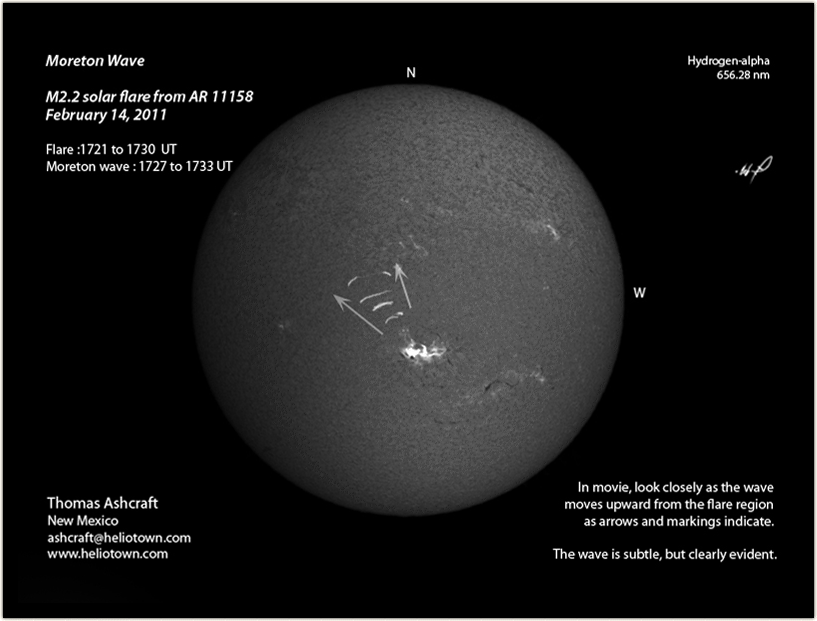 |
||
Moreton Wave : February 14, 2011 | Thomas Ashcraft | Mail |
Observer's Notes: This M2.2 flare lasted from 1720 UT to 1732 UT. The Moreton wave occurred from 1727 UT to 1733 UT. The flare also produced moderate Type II radio sweeps which were recorded on our radio telescope array at 21 MHz and 19 MHz. The sound file and chart are down the page. The time-lapse above is made from extracted stills from full-time video .avi files. The Moreton wave is subtle in the time-lapse but evident. I hope to do more analysis of this event in the near future. - Thomas Ashcraft
From Wikipedia: A Moreton wave is the chromospheric signature of a large-scale solar coronal shock wave. Described as a kind of solar 'tsunami' they are generated by solar flares. They are named for American astronomer Gail Moreton, an observer at the Lockheed Solar Observatory in Burbank who spotted them in 1959. He discovered them in time-lapse photography of the chromosphere in the light of the Balmer alpha transition. There were few follow-up studies for decades. Then the 1995 launch of the Solar and Heliospheric Observatory led to observation of coronal waves, which cause Moreton waves. Moreton waves were a research topic again. The reality of Moreton waves (aka fast-mode MHD -magnetohydrodynamic - waves) has also been confirmed by the two STEREO spacecraft. They observed a 100,000-km high wave of hot plasma and magnetism, moving at 250 km/second, in conjunction with a big coronal mass ejection in February 2009. Moreton waves propagate at a speed of 500-1500 km/s, and occur where a coronal magnetohydrodynamic fast-mode weak shock wave intersects the chromosphere according to a well-known theory of Yutaka Uchida that links them to radio type II bursts. Moreton waves can be observed primarily in the Hydrogen-alpha band.
Below: Type II Radio Sweeps at 21.1 MHz Listen to radio reception of the "shock front" in chart below: 1 min 40 sec.
Observer: Thomas Ashcraft | New Mexico | More observations - Heliotown | Mail Optical Telescope : Lunt 60/50mm double -stacked H-a .5Å : Camera : DMK 41 |
||
. |
||
